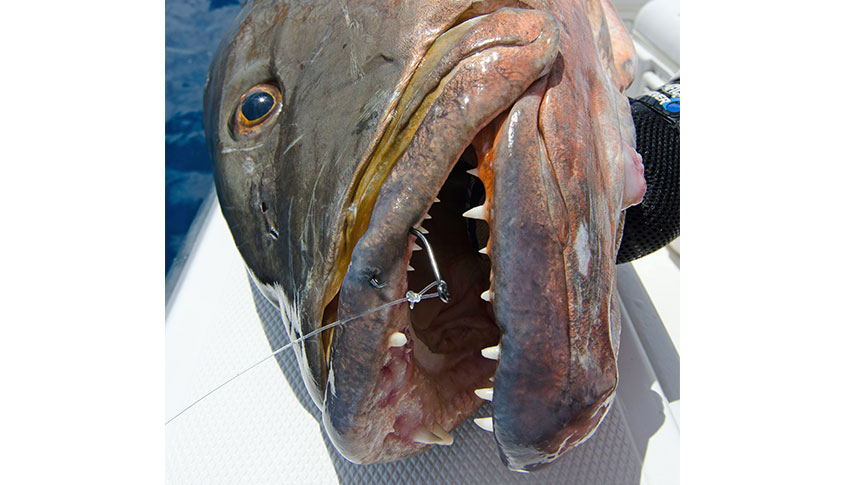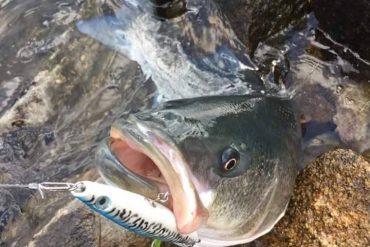Light Tackle Connections for Baiting Big Game
Although it took a considerable amount of time for circle-hooks to be accepted throughout the angling community, they have since proven their effectiveness across a wide variety of venues by converting hookups into healthy releases. While in-line circle-hooks definitely reduce gut hooking, once the point has buried into the fish’s jaw it’s not often the fish can throw the hook. When used and sized properly to the target species and specific offering, circle-hooks greatly improve hooking efficiency.

As circle-hook design and construction came to fruition anglers began developing new rigging techniques and perfected the process, all the way down to specific knots for certain applications and hook styles. Although you can certainly attach a circle-hook with a simple uni or clinch knot, to really capitalize on the effectiveness of the hook design it’s very important you pay close attention to the details.
…the directional pull afforded by snelling puts the hook where it needs to be and consistently catches fish in the corner of the jaw.
LOOP
Presenting live bait on relatively light tackle is a favored technique of anglers across numerous fisheries throughout the world’s oceans, but nobody does it better than the crews in South Florida. With copious amounts of various forage species readily available, and the near-shore reef line concentrating predator and prey, anglers have found great success fishing live bait and have developed specialized tactics and techniques for catching, penning, transporting and fish-ing with an assortment of frisky offerings. Nothing is overlooked and everything is done with purpose.
When fishing live bait off a kite, lo-cal anglers prefer to attach fluorocarbon leader material to the circle-hook with a small loop knot. This might not seem like a tournament winning tip, but the tiny adjustment enables the hook to swing freely and independently from the leader, resulting in live bait presented with more natural behavior due to the slightly reduced resistance. With a knot fastened tight to the hook eye the entire presentation will be stiffer and won’t appear as inviting.
There are numerous types and styles of circle-hooks, but when fishing live bait you want to select a straight eye circle-hook matched to the size of your bait, with a hook gauge suitable for the size of the game fish you are targeting and amount of drag you will apply. When tying a perfection loop or non-slip loop knot, be sure the end result is a tiny knot that isn’t obtrusive. You may not think something so slight can make a noticeable difference, but after you’ve won multiple tournaments with a certain strategy and rigging technique it’s hard to say it doesn’t work. The only drawback to a loop knot is that the free swinging circle-hook can double back over the bait or leader.
SNELL
Part of the draw of recreational sport fishing is that there’s always something to learn. You may have a preferred technique that works for your home waters, but that’s not to say you shouldn’t keep an open mind on how others do it out-side your comfort zone. While dolphin, sailfish, tuna and more can be captured with live bait, they are also commonly pursued by anglers trolling rigged ballyhoo. Here, the speed of the boat helps dead bait appear alive, but again the most dialed-in crews that fish the same waters year after year have seen what works and what doesn’t.
When trolling rigged ballyhoo it’s clear that the pros prefer to snell their circle-hooks. From Guatemala to Costa Rica, Isla Mujeras to Key West, and Stu-rt to Ocean City, this is how the top crews attach circle-hooks to fluorocarbon leader. Whether you prefer a circle-hook with an offset octopus eye or in-line flat eye, the directional pull afforded by snelling puts the hook where it needs to be and consistently catches fish in the corner of the jaw.
No matter the scenario, it’s important the circle-hook is fully exposed. Additionally, when a fish picks up your bait you want to have the reel set with light drag pressure so the fish can turn and swim away without feeling any resistance.
While the most experienced anglers understand the slight variances and different characteristics of all hooks and how to properly present them based on the prevalent conditions and target species, the everyday angler will find greater success by focusing on finding areas with good current and acquiring the freshest bait, dead or alive, than worrying about which knot to tie or whether to choose a circle-hook with an offset or in-line eye. As your experiences grow and you incorporate circle-hooks into your spread you’ll soon understand the inherent advantages of specific rigging techniques.
Light Tackle Connections for Baiting Big Game
Although it took a considerable amount of time for circle-hooks to be accepted throughout the angling community, they have since proven their effectiveness across a wide variety of venues by converting hookups into healthy releases. While in-line circle-hooks definitely reduce gut hooking, once the point has buried into the fish’s jaw it’s not often the fish can throw the hook. When used and sized properly to the target species and specific offering, circle-hooks greatly improve hooking efficiency.

As circle-hook design and construction came to fruition anglers began developing new rigging techniques and perfected the process, all the way down to specific knots for certain applications and hook styles. Although you can certainly attach a circle-hook with a simple uni or clinch knot, to really capitalize on the effectiveness of the hook design it’s very important you pay close attention to the details.
…the directional pull afforded by snelling puts the hook where it needs to be and consistently catches fish in the corner of the jaw.
LOOP
Presenting live bait on relatively light tackle is a favored technique of anglers across numerous fisheries throughout the world’s oceans, but nobody does it better than the crews in South Florida. With copious amounts of various forage species readily available, and the near-shore reef line concentrating predator and prey, anglers have found great success fishing live bait and have developed specialized tactics and techniques for catching, penning, transporting and fish-ing with an assortment of frisky offerings. Nothing is overlooked and everything is done with purpose.
When fishing live bait off a kite, lo-cal anglers prefer to attach fluorocarbon leader material to the circle-hook with a small loop knot. This might not seem like a tournament winning tip, but the tiny adjustment enables the hook to swing freely and independently from the leader, resulting in live bait presented with more natural behavior due to the slightly reduced resistance. With a knot fastened tight to the hook eye the entire presentation will be stiffer and won’t appear as inviting.
There are numerous types and styles of circle-hooks, but when fishing live bait you want to select a straight eye circle-hook matched to the size of your bait, with a hook gauge suitable for the size of the game fish you are targeting and amount of drag you will apply. When tying a perfection loop or non-slip loop knot, be sure the end result is a tiny knot that isn’t obtrusive. You may not think something so slight can make a noticeable difference, but after you’ve won multiple tournaments with a certain strategy and rigging technique it’s hard to say it doesn’t work. The only drawback to a loop knot is that the free swinging circle-hook can double back over the bait or…





